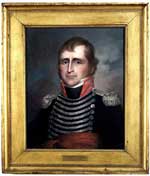From the collection of:
The Owensboro Museum of Fine Art || VAM Home
Charles Willson Peale (American, 1741-1827)
COLONEL JOSEPH HAMILTON DAVEISS, late 1700s/early 1800s
Oil on canvas; 28" X 22"
Collection of Owensboro Museum of Fine Art
This formal portrait shows Col. Joseph Hamilton Daveiss, a prominent Federalist lawyer. Daveiss was born in Bedford County, Virginia, in 1774. In his 20s, after several years of fighting Native Americans, he studied law. In 1800, John Adams appointed Daveiss federal district attorney for Kentucky. In 1801, Daveiss became the first lawyer from west of the Alleghenies to argue before the U.S. Supreme Court, and in 1803 he married the sister of U.S. Chief Justice John Marshall. In 1806, Daveiss prosecuted Aaron Burr, the former vice president under Thomas Jefferson, for treason, accusing Burr of plotting to seize Spanish territory and to wrest the western territory from the Union. Though he did not obtain a conviction, the trial is one of the most renowned in Kentucky history.
Daveiss died at the Battle of Tippecanoe in 1811. Daviess County, the 58th county to be formed in Kentucky, was named for him. Owensboro is its county seat. (Apparently, the i and the e in Daveiss’ name were accidentally switched in the legislation creating the county.)
About the Artist
Charles Willson Peale was born in Queen Anne’s County, Maryland, on April 15, 1741. He pursued knowledge of all sorts, and his curiosity guided investigations in mechanics, literature, art, and science. After studying art with American painter Benjamin West (1738-1820), who later helped form the Royal Academy of Art, Peale became one of the most widely recognized portrait painters in Colonial America. He is thought to have painted more than 1,000 portraits. Among his many sitters were John Quincy Adams, John Hancock, Andrew Jackson, Thomas Jefferson, and George Washington—who sat for him on multiple occasions.
Peale’s personal home gallery grew to include artworks, various cultural artifacts, natural history specimens, and examples of advancing technology. In 1786, the collection was formalized into “Peale’s Museum,” the first of its kind in the nation. Also known as the Philadelphia Museum, it is remembered for the 1801 excavation of the Newburgh, New York, mastodon bones and their subsequent public display as an assembled skeleton.
Paintings by Peale are included in the collections of the Colonial Williamsburg Foundation in Virginia, the Metropolitan Museum of Art in New York, the Museum of Fine Arts in Boston, the National Gallery of Art in Washington, DC, and the Pennsylvania Academy of Fine Arts. Peale became the patriarch of an extraordinary family of American painters, including his children Raphaelle (1774-1825), Rembrandt (1778-1860), Rubens (1784-1865), and Titian Ramsay (1799-1885); his niece Sarah Miriam Peale (1800-1885); and his nephew Charles Peale Polk (1767-1866).
Classroom Ideas
Discussion: What does this portrait show us about the subject? Does it suggest inside character as well as outside character? The portrait projects an attitude of respect for the role of the soldier. Would the viewer feel differently about Daveiss if he were depicted covered in the dirt and smoke from battle? Discuss the role the artist has in choosing how a person is portrayed; i.e., what is included in the painting and what is left out. Also, how are the elements of art used to support the portrayal? Look for other examples of Peale’s portraits of “elite” Colonials. Do you think they are accurate portrayals?
Before photography, portrait painting was used to capture a person’s image. How is a painted portrait different from a photograph? How are they similar? Does one necessarily portray a more realistic view of the subject?
Activity: Create a portrait of someone you admire, using the elements of art and principles of design to convey both character and appearance. Compare your portrait to a photograph of the person.
Links
The National Portrait Gallery web site includes extensive Peale family papers and writings.
[www.npg.si.edu/exh/peale/]

